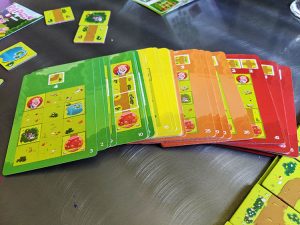Like most homes with elementary school-aged kids, children’s stories are a staple in my home. They spark kids’ interests and imaginations. One of those early stories we all were introduced to is the Three Little Pigs. You know the story, it involves houses of straw, wood, and brick and a certain nefarious wolf who likes to huff and puff.
It is that hammy trio that provides us the backdrop for Pig Puzzle, a solo game from Blue Orange Games.
Gameplay Overview:
Pig Puzzle offers various modular puzzles with 4 levels of difficulty, where you and your kiddo work out how to get your little piggies to their homes.
After the desired puzzle is selected, you’ll put together the underlying map, laying down your pigs, their homes, and any obstacles like the wolf according to the puzzle card. Gather all the tiles required for the puzzle; this will provide the pieces needed to create a path for the pigs to get home. The only rule of thumb for building the route is that it must lead all pigs to their respective homes with no dead ends. Once a solution has been found, flip over the puzzle card to check for accuracy.

Game Experience:
Since this is a game aimed at children, this review will be a little different from what I typically write. My criteria here will be a few items: what ages are this most appropriate, build quality (how quickly might my kids destroy this), value, and teaching moments.
Given the bright coloring and artwork, younger children will easily gravitate towards this. It is exactly the art style one would expect from a children’s game. In terms of ages, I think kids from 5 to 9 will probably enjoy this most. Certainly, an adult being engaged and present helping them figure these puzzles out will be most helpful, especially if they are younger. This might also open up the possibility for them to try harder puzzles they might not attempt on their own.

The build quality for the game is pretty good. All the components fit easily in the magnetized lid box. You could easily ask your kids to bring the game over to the table and not need to worry that the lid is going to dump all the components out. The cards and tiles are built in such a way that they can handle children picking them up and placing them. One thing I did notice that happened a lot was when my kids would place a tile down near or next to one that was already laid, they easily knocked out of place those adjacent. For those less dexterous young ones, this will happen often so be prepared to readjust the tiles. It can be a little frustrating, making one wish that the board and pieces were also somehow magnetized to help with this issue.
One negative I found with the components was that they don’t have an interactive quality to them in terms of play. Kids enjoy playing and interacting with their world; this game doesn’t allow for that level of interaction, which I think could hinder their future interest.

The value this game provides is more than appropriate for the price paid. As mentioned, there are four levels of difficulty and some puzzles will simply be beyond the reach of younger kids without adult help. Because this is a game with a small footprint, it wouldn’t be burdensome for it to stick around for a while, offering something new and challenging for your kids as they get older. The game does offer 60 puzzles; however, they are not equally averaged for each difficulty level. The two easiest levels have 10 challenges each, while the more difficult ones have 20. I would have liked to see a more even spread just because I do think more younger kids will gravitate to the game first and might be limited with how much they can get out of this game because there are less challenges at their level.
Lastly, this game offers some great lessons in path logic and problem-solving. How does pig 1 get from point a to point b using only certain tiles? Sitting down with my kids, we looked at and talked about how certain paths curved in a certain direction, what would happen if we oriented the tile another way and how we were trying to connect pieces. This could be mentally taxing, especially for younger kids so just be aware of your kid’s capability. We typically did one puzzle at a time and my kids are 5 and 6. Keeping it light, even if it’s challenging, will keep them wanting to try new puzzles. Otherwise, this will seem like homework. And that’s not fun.
Final Thoughts:
Pig Puzzle is a neat little game that can help facilitate problem solving and logic for your young ones. The artwork is attractive and will draw kids to the table. The fun and interactive factor the game offers is low. Parents with younger kids may have to fill in that missing interactive play piece to keep them wanting to play this in the future.
Final Score: 3 Stars – a familiar-themed logic puzzle that’s attractive, but not as interactive as young kids might appreciate
Hits:
• Teaches logic/problem solving with attractive artwork and familiar characters
• Wide variety of puzzles with various levels of difficulty
Misses:
• Could burn kids out, who might equate this with homework if played too long (especially with younger kids)
• Lacks more engaging components found in children’s games that helps foster future interest in playing























